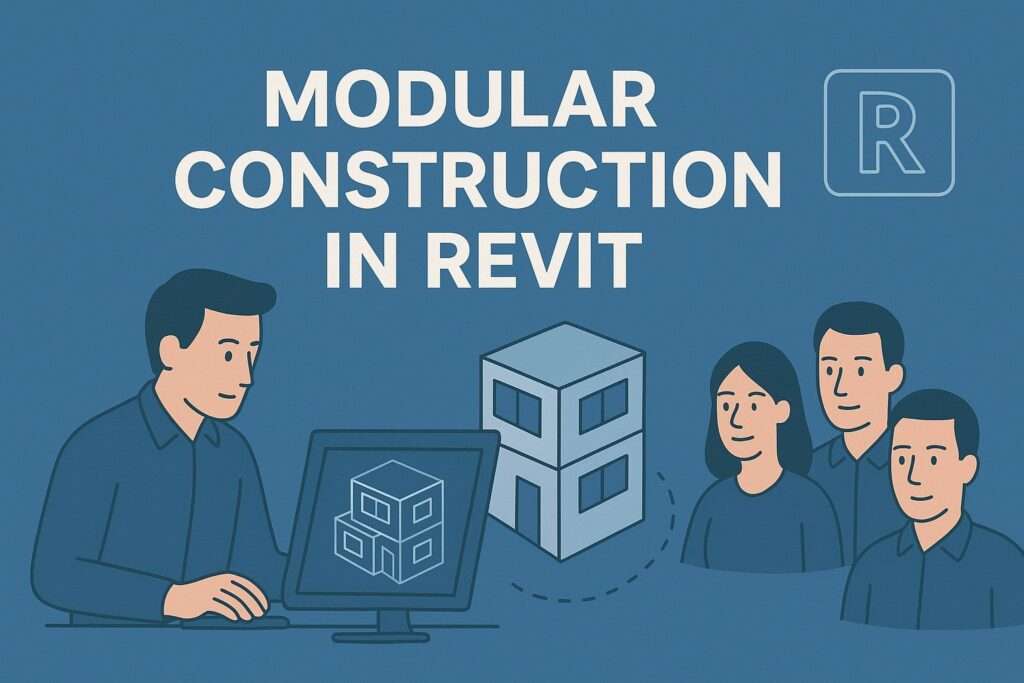OUTSOURCE CREATIVE SERVICES - OUTSOURCE CREATIVE WORKS-OUTSOURCING CREATIVE WORK - OUTSOURCE CREATIVE DESIGN -OUTSOURCE 2D ARTWORKS - 2D ART SERVICES - 2D ART OUTSOURCING -ART OUTSOURCING - OUTSOURCE ILLUSTRATION WORKS - OUTSOURCE ILLUSTRATION SERVICES - OUTSOURCE 3D MODELING - 3D MODEL OUTSOURCING- OUTSOURCING CAD WORKS- OUTSOURCE ARCHITECTURAL SERVICES -BIM - REVIT - 3D FLOOR PLAN - BIM OUTSOURCING SERVICES - MEP - REVIT MODELING - 3D FURNITURE MODELING - 3D ARCHITECTURE MODELING - AUGMENTED REALITY MODEL - VIRTUAL REALITY MODEL - 3D RENDERING - PRODUCT MODELING - 2D SERVICES - OUTSOURCE CREATIVE SERVICES -3D MODELING SERVICES - VFX
Offshore Revit Teams for Modular Projects: How to Succeed
Modular construction represents a powerful shift toward industrializing the building process. By manufacturing components off-site in controlled environments, modular projects promise greater speed, superior quality control, and reduced waste. However, the success of this industrialized approach hinges entirely on one foundational element: digital precision.

In the digital construction world, Revit Services are the standard bearer. Revit's parametric modeling capabilities, clash detection tools, and robust documentation features make it the ideal platform for managing the complex, repetitive, and highly standardized nature of modular design.
As demand for modular projects surges globally, AEC firms are increasingly turning to offshore partners to handle the intensive, specialized BIM Services required. Engaging Offshore Revit Teams for modular projects is not just about CAD Outsourcing—it's a high-stakes strategic decision. It requires a clear understanding of what to expect and, more importantly, a precise playbook for success.
Modular construction is the future of building—a shift from unpredictable, site-based chaos to factory-controlled, efficient precision. This industrial approach demands an equally industrialized design process, and the core technology enabling this is Building Information Modeling (BIM), primarily driven by Revit.
🏗️ What to Expect from an Offshore Revit Team in Modular Construction
Modular construction is fundamentally different from traditional construction. It relies on standardization, repetition, and a DfMA (Design for Manufacture and Assembly) mindset. An offshore team must be set up to meet these specific demands.
1. High-Volume Production Capacity
The primary expectation from an offshore team is massive scalability. Modular construction often involves large-scale, repetitive projects (e.g., apartment blocks, student housing, hotel chains).
- CAD Outsourcing provides the muscle to quickly convert design intent into hundreds of fabrication-ready BIM models. An offshore partner can instantly scale resources from a handful of modelers to dozens, ensuring that a surge in demand for module documentation is met without delaying the factory floor.
- Focus on Documentation: The offshore team excels at the labor-intensive tasks: creating detailed shop drawings, fabrication drawings, spool drawings, and extracting Quantity Takeoffs (QTOs) directly from the Revit model.
2. Expertise in Standardized Revit Workflows
For modular to work, design must be uniform. A successful offshore team is not just proficient in Revit; they are experts in BIM standardization.
- Revit Family Mastery: Expect the team to be highly proficient in creating and working with your firm's standardized, parametric Revit Family library. These families, which represent pre-engineered modules, wall panels, or MEP assemblies, are the digital "products" that the factory manufactures.
- Adherence to BEP (BIM Execution Plan): The team must rigorously follow your company’s specific BIM Execution Plan, ensuring consistent modeling practices, naming conventions, layering standards, and quality checks across all projects. This is non-negotiable for modular consistency.
3. Integrated Multi-Disciplinary Coordination
Modular projects are highly integrated, requiring seamless coordination between Architecture, Structure, and MEP systems within the module.
- Clash Detection: The offshore BIM Services team is expected to perform continuous, rigorous clash detection to resolve hard and soft clashes between trades before the model is approved for fabrication. Finding a clash in the factory is exponentially more expensive than finding it in the digital model.
- Modular Splitting: The team must understand how to model and "split" the design precisely along the physical module break lines, ensuring accurate geometry for site assembly and transport logistics.
🤝 How to Succeed: Strategies for Seamless Offshore Integration

Success with an offshore Revit Services team in modular construction is not accidental; it is built on a foundation of clear processes, defined communication, and mutual trust.
I. Process Standardization is Paramount
The modular nature of the work requires you to first standardize your internal processes before you Outsourcing cad works. The offshore team executes your standard; they don't invent it.
- Develop a Master Revit Template:
Create one master template loaded with your company’s custom settings, standardized Revit Services families (especially modular units), line weights, view templates, and title blocks. The offshore team must use this template exclusively. - Document the BIM Execution Plan (BEP) and Standards: The BEP must detail everything: modeling hierarchy (use of groups vs. assemblies), required Level of Development (LOD), element naming conventions, file sharing protocols, and quality assurance checklists. This document serves as the "Rule Book" for all CAD Outsourcing deliverables.
- Define Deliverables and Checklists: Clearly state the required outputs—e.g., "LOD 400 module model," "BIM data extracted to COBie format," or "Fabrication drawings generated at 1:20 scale." Use checklists for every deliverable to enforce consistency and facilitate the internal QA process.
II. Communication and Time-Zone Strategy
Bridging the geographical and cultural gap is the single most critical factor for success in Outsourcing cad Services.
- Establish a Single Point of Contact (SPOC): Assign a dedicated, technically proficient project manager on both the onshore and offshore sides. The onshore SPOC is responsible for clear briefing, technical oversight, and final quality control. The offshore SPOC manages the day-to-day team and coordinates production.
- Embrace Asynchronous Communication and Documentation: Given the time difference, real-time meetings should be limited to high-impact sessions (clash resolution, design review). Document all decisions in a centralized location (cloud-based project management tools like BIM 360, Procore, or simple shared drives). This ensures that the team starting their shift has all the necessary updates from the team that just finished.
- Leverage the "Follow the Sun" Model Strategically: Use the time difference to your advantage. Your onshore team should spend their afternoon preparing detailed, clear briefs and markups. The offshore team performs the labor-intensive modeling overnight, and the completed model is ready for the onshore team to review when they arrive. This effectively creates a 24-hour workday, accelerating the project timeline.
III. Treat Them as an Extension of Your Team
The most successful firms treat their offshore teams not as vendors, but as an integral extension of their in-house staff.
- Full System Integration: Provide the offshore team with access to your secured network environment, your master Revit files (via work-sharing and cloud platforms), and all internal project management systems. This integration fosters a shared sense of ownership.
- Invest in Onboarding and Training: The initial weeks are crucial. Invest time in training the offshore team on your specific modular details, proprietary connection methods, and software customizations. Use the first project as an intensive, collaborative training exercise.
- Regular Video Collaboration: Hold regular, scheduled video meetings (even if brief) to maintain personal connections and address issues beyond email. Seeing faces helps build trust and cultural understanding, which is vital for smooth team dynamics in Outsourcing Architectural Services.
📊 The Strategic Payoff for Modular Firms

When implemented correctly, the integration of an offshore Revit Services team provides modular firms with a decisive competitive edge.
1. Cost Predictability and Reduction (5D BIM)
Modular construction aims for predictability, and an offshore team helps realize this goal digitally. Because the team works from standardized components, they can provide high-accuracy Quantity Takeoffs (QTOs) directly from the model, enabling 5D BIM. This reduces material waste, improves procurement planning, and locks in cost predictability early in the design phase.
2. Focus on Innovation, Not Drafting
By Outsourcing cad Services for repetitive module modeling and documentation, the high-value in-house architectural team is freed to focus on innovation—improving the core product design, optimizing module layouts, client liaison, and complex site-specific architectural challenges. The offshore team handles the production line, allowing the onshore team to focus on the R&D.
3. De-risking Project Delivery
Modular construction is unforgiving: one error in the model can halt a multi-million dollar assembly line. The offshore team's rigorous adherence to standardized QA checklists and continuous clash detection acts as a powerful risk mitigation tool. Their specialization in BIM Services and dedication to detailed documentation ensures the models that reach the factory are clean, coordinated, and fabrication-ready, saving immense time and money in construction rework.
🎯 Conclusion: Mastering the Modular Digital Workflow
By establishing clear standards, leveraging robust CDE technology, and committing to meticulous communication protocols, firms can effectively transform an Outsourcing cad works agreement into a powerful, scalable partnership. When managed correctly, offshore BIM Services teams become the indispensable engine that drives the industrialized, digital future of Outsourcing Architectural Services
The decision to establish an Offshore Revit Team for modular construction projects is a strategic necessity for firms seeking to scale efficiently and globally. Success hinges on a clear understanding that the partnership is not about cheap labor, but about leveraging specialized BIM expertise in a standardized, controlled, and scalable environment.
By standardizing your Revit Services workflows, clearly documenting your expectations in a comprehensive BEP, and establishing open, structured communication with your Outsourcing cad works partner, you can effectively build a highly efficient, 24/7 digital factory. This integration is the key to unlocking the full potential of industrialized construction and securing market leadership in the future of the AEC industry.
❓ FAQs
1. What is the primary benefit of using an offshore team for modular design?
The primary benefit is scalability and cost efficiency. An offshore team allows a modular firm to quickly increase production capacity for Revit Services and documentation (like shop drawings) without incurring the high, fixed costs and lengthy process of hiring specialized local staff.
2. How do offshore teams ensure quality and consistency in BIM models?
Quality is ensured through strict adherence to the client's BIM Execution Plan (BEP) and a Master Revit Template. The Outsourcing Architectural Services provider must use the client's standardized component libraries (Revit Families) and follow rigorous internal QA/QC checklists before delivery.
3. What is the biggest challenge when working with Outsourcing cad Services offshore?
The biggest challenge is communication and time-zone coordination. Success requires establishing a clear Single Point of Contact (SPOC) on both sides, relying heavily on detailed asynchronous documentation, and strategically using the "follow-the-sun" model for a 24-hour workflow.
4. What is the main focus of the offshore BIM Services team for modular projects?
The main focus is production and coordination. This includes high-volume module modeling, generating detailed fabrication drawings, performing continuous multi-disciplinary clash detection, and extracting accurate Quantity Takeoffs (QTOs) for cost estimation.
5. How does the offshore team handle proprietary information and data security?
Reputable Outsourcing cad works partners maintain secure, dedicated network environments and sign strict Non-Disclosure Agreements (NDAs). Access to project files is often managed via secure cloud platforms (like BIM 360) with restricted user permissions, ensuring client data remains safe and confidential.
6. Should the offshore team create the initial design concept?
Typically, no. The in-house team focuses on high-level design, client relations, and core design innovation. The offshore Revit Services team specializes in execution—taking the validated design concept and turning it into detailed, fabrication-ready BIM models and documentation according to the firm's strict standards.

No comments:
Post a Comment